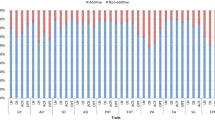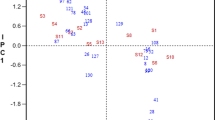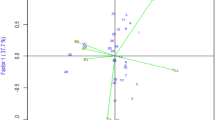Abstract
Maize (Zea mays L.) yields are significantly lower in the tropical-highlands than other environments predominantly due to the lack of well-adapted and improved cultivars and due to genotype by environment (G × E) interaction. The objectives of this study were to determine G × E interaction and yield stability of quality protein maize (QPM) single-cross hybrids recently developed from tropical-highland adapted inbred lines, and to identify promising genotypes and representative test and seed production environments. The study was conducted at seven environments representing the tropical-highland sub-humid maize growing agro-ecology in Ethiopia. Sixty-six QPM hybrids and two commercial check hybrids were evaluated using a 4 × 17 alpha lattice design. Data were analysed using the additive main effects and multiplicative interaction (AMMI) and genotype and genotype by environment (GGE) biplot methods. Using AMMI analysis, four promising QPM hybrids were identified compared to the commercial checks and designated as hybrid 10 (KIT32 × 142-1-eQ), hybrid 66 (142-1-eQ × CML144), hybrid 59 (FS60 × 142-1-eQ), and hybrid 38 (FS67 × CML144) with grain yields of 10.3, 9.6, 9.4 and 8.9 t ha−1, respectively. The same hybrids were identified as the best performers for being close to the ideal cultivar using the GGE biplot analysis. The GGE analysis delineated the test environments into two mega-environments useful for targeted evaluation of genotypes and effective maize breeding and seed production. Kulumsa site during 2013 (KUL13) was the most suitable environment in discriminating the QPM hybrids and being a representative test environment.




Similar content being viewed by others
References
Banziger M, Diallo AO (2000) Stress tolerant maize for farmers in sub-Saharan Africa. Maize research highlights. CIMMYT, Mexico, DF, pp 1–8
Bigirwa G, Pixley K, Asea G, Lipps P, Gordon S, Pratt R (2003) Uses of IPM in the control of multiple diseases in maize: strategies for selection of host resistance. Afr Crop Sci J 3:89–198
CIMMYT (1999) CIMMYT 1997/1998 world maize facts and trends. CIMMYT, Mexico, DF
Cooper M, DeLacy IH, Basford KE (1996) Relationships among analytical methods used to analyse genotypic adaptation in multi-environment trials. In: Cooper M, Hammer GL (eds) Plant adaptation and crop improvement. CAB International, Wallingford, pp 193–224
Cooper M, Stucker RE, DeLacy IH, Harch BD (1997) Wheat breeding nurseries, target environments, and indirect selection for grain yield. Crop Sci 37:1168–1176
Demissew A, Hussein S, Derera J, Laing MD (2013) Farmers’ perceptions of maize production systems and breeding priorities, and their implications for the adoption of new varieties in selected areas of the highland agro-ecology of Ethiopia. J Agr Sci 5:159–172
Demissew A, Shimelis H, Derera J, Kassa S (2015) Genetic purity and patterns of relationships among tropical highland adapted quality protein and normal maize inbred lines using microsatellite markers. Euphytica 204:49–61
Derera J, Tongoona P, Pixley KV, Vivek B, Laing MD, Rij NC (2008) Gene action controlling grey leaf spot resistance in Southern African maize germplasm. Crop Sci 48:93–98
DeVries J, Toenniessen G (2001) Securing the harvest: Biotechnology, breeding and seed systems for African crops. CABI Publishing, Wallingford
FAOSTAT (2014) The Food and Agricultural Organization of the United Nations: the statistical database. http://faostat.fao.org. FAO, Rome
Frashadfar E, Safari H, Jamshidi B (2012) GGE biplot analysis of adaptation in wheat substitution lines. Int J Agric Crop Sci 4:877–881
Gabriel KR (1971) The biplot graphic display of matrices with application to principal component analysis. Biometrika 58:453–467
Gauch HG, Zobel RW (1996) AMMI analyses of yield trials. In: Kang MS, Gauch HG (eds) Genotype by environment interaction. CRC Press, Boca Raton, pp 85–122
Gauch HG, Zobel RW (1997) Identifying mega-environments and targeting genotypes. Crop Sci 37:311–326
Hallauer AR, Carena MJ, Miranda JB (2010) Quantitative genetics in maize breeding. Springer Science + Business Media, New York
Kandus M, Almora D, Ronceros RB, Salenro JC (2010) Statistical models for evaluating the genotype-environment interaction in maize (Zea mays L.). Phyton 79:39–46
Kassa Y, Asea G, Demissew A, Ligeyo D, Demewoz N, Saina E, Serumaga J, Afriyie ST, Opio F, Rwomushana I, Gelase N, Gudeta N, Wondimu F, Solomon A, Habtamu Z, Andualem WB, Habte J, Mduruma Z (2013) Stability in performance of normal and nutritionally enhanced highland maize hybrid genotypes in eastern Africa. Asian J Plant Sci 12:51–60
Krivanek AF, De-Groote H, Gunaratna NS, Diallo AO, Friesen D (2007) Breeding and disseminating quality protein maize (QPM) for Africa. Afr J Biotechnol 6:312–324
Menkir A, Ayodele AM (2005) Registration of 20 tropical mid-altitude maize line sources with resistance to gray leaf spot. Crop Sci 45:803–804
Nzuve F, Githiri S, Mukunya DM, Gethi J (2013) Analysis of genotype × environment interaction for grain yield in maize hybrids. J Agric Sci 5:75–85
Patterson HD, Williams ER (1976) A new class of resolvable incomplete block designs. Biometrika 63:83–89
Payne RW, Harding SA, Murray DA, Soutar DM, Baird DB, Glaser AI, Welham SJ, Gilmour AR, Thompson R, Webster R (2007) GenStat® release 14 statistical software for windows. VSN International Ltd, Hemel
Pixley KV, Bjarnason MS (2002) Stability of grain yield, endosperm modification, and protein quality of hybrid and open-pollinated quality protein maize (QPM) cultivars. Crop Sci 42:1882–1890
Purchase JL (1997) Parametric analysis to describe G × E interaction and yield stability in winter wheat. PhD Thesis, University of the Orange Free State, Bloemfontein, South Africa
SAS (2002) The SAS system for Windows, release 9.3. SAS Institute Inc, Cary
Sibiya J, Tongoona P, Derera J, Rij N (2012) Genetic analysis and genotype by environment (G × E) for grey leaf spot disease resistance in elite African maize (Zea mays L.) germplasm. Euphytica 185:349–362
Taya G, Getachew T, Bejiga G (2000) AMMI adjustment for yield estimate and classification of genotypes and environments in field pea (Pisum sativum L.). J Genet Breed 54:183–191
Thorne PJ, Thornton PK, Kruska R, Reynolds L, Waddington SR, Rutherford AS, Othero AN (2002) Maize as food, feed and fertilizer in intensifying crop livestock systems in East and southern Africa: an ex ante impact assessment of technology interventions to improve smallholder welfare. In: ILRI Impact Assessment Series 11, International Livestock Research Institute (ILRI), Nairobi, Kenya, p 123
Twumasi AS, Zelleke H, Yihun K, Assefa B, Tariku S (2002) Development and Improvement of Highland Maize in Ethiopia. In: Nigusse M, Tanner D (eds) Proceedings of the second national maize workshop of Ethiopia, EARO (Ethiopian Agricultural Research Organization) and CIMMYT, 12–16 November 2001, Addis Ababa, Ethiopia, pp 31–38
Yan W (2001) GGE biplot-a windows application for graphical analysis of multi-environment trial data and other types of two-way data. Agron J 93:1111–1118
Yan W (2002) Singular-value partitioning in biplot analysis of multi-environmental trial data. Agron J 94:990–996
Yan W, Holland JB (2010) A heritability-adjusted GGE biplot for test environment evaluation. Euphytica 171:355–369
Yan W, Kang MS (2003) GGE biplot analysis: a graphical tool for breeders, geneticists, and agronomists. CRC Press, New York
Yan W, Hunt LA, Sheng Q, Szlavnics Z (2000) Cultivar evaluation and mega-environment investigation based on GGE biplot. Crop Sci 40:597–605
Yan W, Kang MS, Ma B, Woods S, Cornelius PL (2007) GGE biplot vs. AMMI analysis of genotype-by-environment data. Crop Sci 47:643–655
Zobel RW, Wright MJ, Gauch HG (1988) Statistical analysis of yield trial. Agron J 80:388–393
Acknowledgments
The Alliance for a Green Revolution in Africa (AGRA) is sincerely thanked for financial support of the study. The Ethiopian Institute of Agricultural Research (EIAR) is acknowledged for providing the first author’s leave of absence and for hosting the field research.
Author information
Authors and Affiliations
Corresponding author
Ethics declarations
Conflict of interest
The authors have not declared any conflict of interest.
Rights and permissions
About this article
Cite this article
Abakemal, D., Shimelis, H. & Derera, J. Genotype-by-environment interaction and yield stability of quality protein maize hybrids developed from tropical-highland adapted inbred lines. Euphytica 209, 757–769 (2016). https://doi.org/10.1007/s10681-016-1673-7
Received:
Accepted:
Published:
Issue Date:
DOI: https://doi.org/10.1007/s10681-016-1673-7




